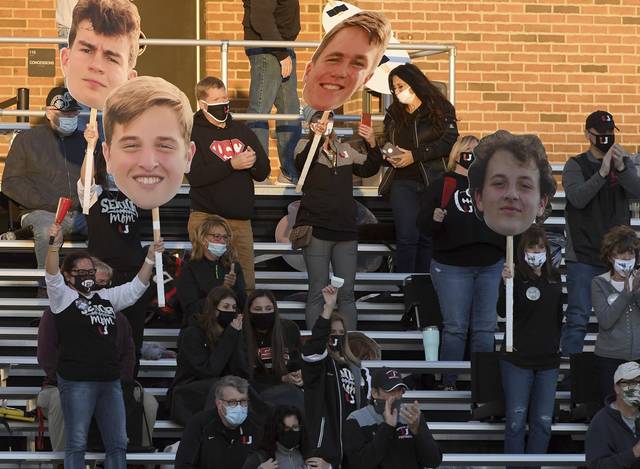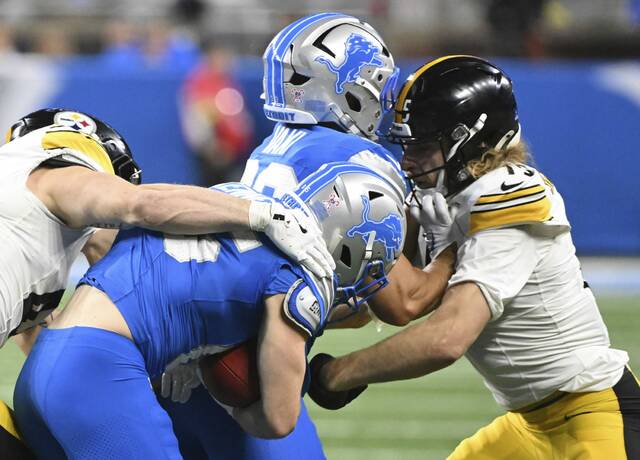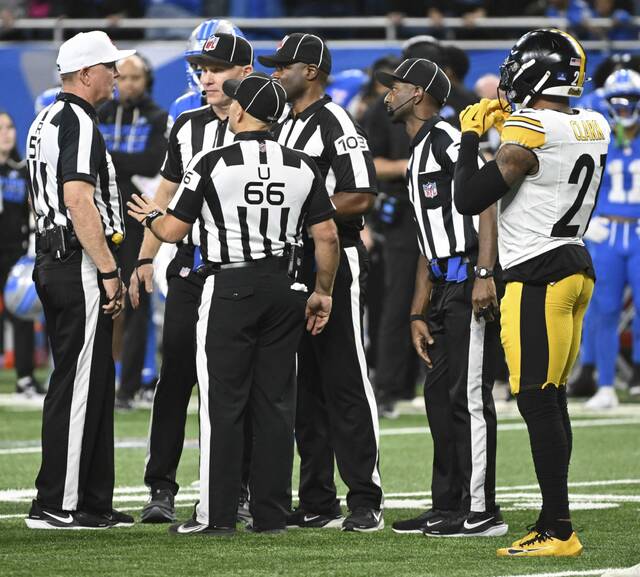Gov. Tom Wolf increased gathering-size limits for events statewide Tuesday, revealing a new formula that’s based on a percentage of a facility’s capacity rather than the 25-person indoor and 250-person outdoor restrictions previously imposed.
Indoor events are limited to 10% to 20% of capacity, depending upon the venue’s size, and outdoor events can admit 15% to 25%. The largest venues are capped at 3,750 individuals indoors and 7,500 outdoors.
The move clears the way for spectators at interscholastic, college and professional sporting events. School districts can allow additional fans at football games, volleyball matches and all other fall contests when the new restrictions take effect Friday. The Pittsburgh Steelers announced plans to admit fans Sunday at Heinz Field for the first time this season.
The state’s gathering limit counts players, coaches, staff and all other game-day workers toward the overall total, so the Steelers will allow 5,500 fans. The team will randomly select from among its season-ticket holders for this week’s game against the Philadelphia Eagles.
“I know that as a football team we will be excited if we have an opportunity to perform in front of fans at our home venue,” Steelers coach Mike Tomlin said. “Man, they inspire us and we look forward to entertaining them.”
Tailgating won’t be permitted in Heinz Field parking lots.
Pitt football, which plays at Boston College this Saturday and at Miami on Oct. 17 before returning to Heinz Field to host Notre Dame Oct. 24, has yet to announce its attendance plans.
“We are pleased and appreciative to receive the new guidelines from the governor’s office today,” director of athletics Heather Lyke said in a statement. “Even with new allowances for attendance, we will remain as vigilant as ever in prioritizing health and safety in each of our sports venues.”
Lyke said Pitt will consult with Allegheny County and university officials before finalizing plans to allow fans to attend games. Pitt also will host Virginia Tech on Nov. 21.
“We will closely monitor cases and outbreaks and if our case investigation and contact tracing efforts determine that events or gatherings are the source of an outbreak, we can and will dial back these new limits,” Health Secretary Rachel Levine said in statement. “Public health and safety are our first concern and will always remain as such.”
According to the new formula, for indoor events with a facility capacity up to 2,000 people, the maximum occupancy rate is 20%. For facilities with a capacity of 2,001 to 10,000, the rate is 15%. For facilities that hold more than 10,000, the rate is 10% with a maximum of 3,750 individuals.
Outdoor events have a separate formula.
Facilities that hold 2,000 or fewer people can allow 25% of capacity, those in the 2,001 to 10,000 range are allowed 20% and places that hold more than 10,000 are allowed 15% up to 7,500 individuals.
Tuesday’s announcement from Wolf and Levine defined an event or gathering as “a temporary grouping of individuals for defined purposes that takes place over a limited timeframe, such as hours or days, including fairs, festivals, concerts, or shows and groupings that occur within larger, more permanent businesses, such as shows or performances within amusement parks, individual showings of movies, business meetings or conferences, or each party or reception within a multi-room venue.”
Occupants must continue to wear a mask and practice social distance.
Wolf’s administration noted that individuals sharing space in a “regularly occurring” setting such as a classroom, office building or production floor are not events or gatherings.
The new guidelines come three weeks after a federal judge in Pittsburgh ruled the governor’s 25- and 250-person limits among other covid-19 restrictions as unconstitutional. Wolf appealed that decision to the 3rd U.S. Circuit Court, which granted him a stay last week.
“Pennsylvanians must continue to social distance and wear masks as we prepare to fight the virus through the fall and winter,” Wolf said Tuesday. “Regardless of the size of an event or gathering, those things are still imperative to stopping the spread of covid. We know everyone has sacrificed in many ways and today’s announcement reflects a gradual adjustment to our lives as we learn how we can do things safely until we have a cure, or an effective vaccine is widely available.”
ABOUT WOLF’S NEW ORDERS ON EVENTS
What’s different?
The Wolf administration’s latest orders regarding large gatherings — announced Tuesday and set to take effect Friday — lift previous pandemic-spurred rules preventing groups of more than 250 or more with a series of percentage limits basedon a venue or outdoor area’s occupancy level.
Limits on indoor spaces are capped at 20% of maximum occupancy for events with fewer than 2,000 people; 15% for between 2,000 and 10,000 people; and 10% for events greater than 10,000 — up to 3,750 people. Outdoor gathering limits increased to up 20% of occupancy at events up to 10,000 people, and 15% of maximum occupancy at events with more than 10,000 — up to 7,500 people total.
Businesses and event venues may choose to be more restrictive with their gathering limitations.
Who/what groups/venues and types of events areimpacted?
Fairs, festivals, concerts, or shows and groupings that occur within larger, more permanent businesses, such as shows or performances within amusement parks, individual showings of movies, business meetings or conferences, or each party or reception within a multi-room venue.
The changes also applies to youth, high school and professional sports.
Also included are bowling alleys and arcades.
Not included are workplaces such as office buildings, classrooms, production floors, school cafeterias or school buses. Businesses still are urged to telework as much as possible.
Nightclubs remain prohibited from operating.
Weddings are discouraged from having dance floors.
Gyms and fitness centers may continue operating with precautions but are “directed to prioritize outdoor physical fitness activities.”
Why were the caps chosen?
The governor’s office says, “At this time, occupancy caps havebeen implemented to prevent gatherings that would compromise the public health or health care infrastructure.Contact tracing, testing availability, and hospital capacity are all important public health measures. An ultra large superspreader event could adversely affect this infrastructure.”
What restrictions remain in place?
Face masks and social distancing still are required at allevents, with the administration noting that venues must enforce those rules and merely posting signs is not enough. Venues further should implement best practices such as timed entry, multiple entry and exit points, multiple restrooms and hygiene stations. Venues and event planners can review the CDCEvents and Gatherings Readiness and Planning Tool foradditional information regarding best practices.
How is occupancy calculated?
Venues should use the National Fire Protection Association(NFPA) Life Safety Code and then apply the attendee calculator to determine how many attendees are permitted to attend theevent or gathering. When no fire code capacity is published or available for outdoor events or gatherings venues, establish occupancy as 67 people per 1,000 square feet and then apply the maximum occupancy calculator. Venues may also contact their local building code officials if they are unaware of their occupancy limit.
Why are events held to a different capacity standard thananother businesses?
The Wolf administration emphasized that “it is important that each type of business or event be considered uniquely and consider the public health risks of the capacity.
“For example, regular dining in small groups allow restaurants to maintain a relatively static environment where patrons canbe kept distanced and in small groups. The structure of a restaurant provides for limited interactions between patrons instead of many individuals having multiple different interactions during an event.
”Events do not provide this level of precaution and instead involve guests moving freely around the space creating more interactions. Additionally, events are also more likely to bring non-household groups together at banquet tables, buffet lines,dance floors, and other mingling opportunities. Events also often have singing, talking, cheering or other opportunities to spread aerosolized or respiratory droplets compared to quiet conversation. Further, events are more likely to have guests arriving at the same or similar time allowing for gathering at entry pinch points.”
Do the orders apply to religious gatherings?
No. Religious gatherings are not affected by the new ordersand have not previously been restricted during the covid-19 pandemic. The state Department of Health continues to encourage places of worship to find alternative ways to hold services, including virtual and outdoors, and to employ social distancing and mask-wearing.
When do the changes take effect?
The amended orders go into effect at 12:01 a.m. Friday, Oct.9.
How will the orders be enforced?
Though some of Wolf’s broader restrictions and stay-at-home orders have been challenged by the court, the Wolf administration said its amended orders will be enforced by thePennsylvania State Police, Pennsylvania Liquor Control Board, Pennsylvania Department of Agriculture, PennsylvaniaDepartment of Health and local law enforcement








